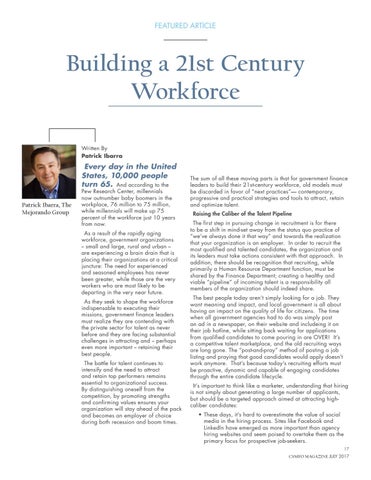FEATURED ARTICLE
Building a 21st Century Workforce Written By Patrick Ibarra
Every day in the United States, 10,000 people turn 65. And according to the Patrick Ibarra, The Mejorando Group
Pew Research Center, millennials now outnumber baby boomers in the workplace, 76 million to 75 million, while millennials will make up 75 percent of the workforce just 10 years from now.
As a result of the rapidly aging workforce, government organizations -- small and large, rural and urban -are experiencing a brain drain that is placing their organizations at a critical juncture: The need for experienced and seasoned employees has never been greater, while those are the very workers who are most likely to be departing in the very near future. As they seek to shape the workforce indispensable to executing their missions, government finance leaders must realize they are contending with the private sector for talent as never before and they are facing substantial challenges in attracting and -- perhaps even more important -- retaining their best people. The battle for talent continues to intensify and the need to attract and retain top performers remains essential to organizational success. By distinguishing oneself from the competition, by promoting strengths and confirming values ensures your organization will stay ahead of the pack and becomes an employer of choice during both recession and boom times.
The sum of all these moving parts is that for government finance leaders to build their 21st-century workforce, old models must be discarded in favor of “next practices”— contemporary, progressive and practical strategies and tools to attract, retain and optimize talent. Raising the Caliber of the Talent Pipeline The first step in pursuing change in recruitment is for there to be a shift in mind-set away from the status quo practice of “we’ve always done it that way” and towards the realization that your organization is an employer. In order to recruit the most qualified and talented candidates, the organization and its leaders must take actions consistent with that approach. In addition, there should be recognition that recruiting, while primarily a Human Resource Department function, must be shared by the Finance Department; creating a healthy and viable “pipeline” of incoming talent is a responsibility all members of the organization should indeed share. The best people today aren’t simply looking for a job. They want meaning and impact, and local government is all about having an impact on the quality of life for citizens. The time when all government agencies had to do was simply post an ad in a newspaper, on their website and includeing it on their job hotline, while sitting back waiting for applications from qualified candidates to come pouring in are OVER! It’s a competitive talent marketplace, and the old recruiting ways are long gone. The “post-and-pray” method of posting a job listing and praying that good candidates would apply doesn’t work anymore. That’s because today’s recruiting efforts must be proactive, dynamic and capable of engaging candidates through the entire candidate lifecycle. It’s important to think like a marketer, understanding that hiring is not simply about generating a large number of applicants, but should be a targeted approach aimed at attracting highcaliber candidates: • These days, it’s hard to overestimate the value of social media in the hiring process. Sites like Facebook and LinkedIn have emerged as more important than agency hiring websites and seem poised to overtake them as the primary focus for prospective job-seekers. 17 CSMFO MAGAZINE JULY 2017
